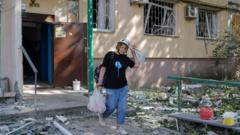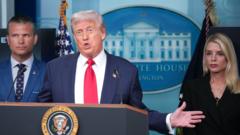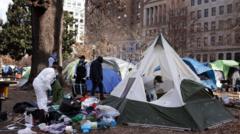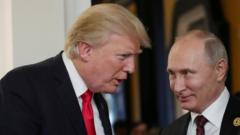As President Trump declares a "crime emergency" in Washington DC, local crime statistics reveal a different story: significant decreases in violent crime over recent years, contradicting claims of an out-of-control situation.
Analyzing Crime Rates in Washington DC: Is It Really Out of Control?

Analyzing Crime Rates in Washington DC: Is It Really Out of Control?
President Trump's claims about rising crime in Washington DC clash with statistics showing a significant decline in violent crime, sparking controversy and debate.
In a recent press conference, President Donald Trump announced plans to deploy hundreds of National Guard troops to Washington DC, stating that crime in the city is out of control and promising to bring "Liberation Day" to residents. He labeled the current state of the nation’s capital as one of “crime, bloodshed, bedlam, and squalor.” However, this narrative stands in stark contrast to the declarations of Mayor Muriel Bowser, who reported that the city is experiencing its lowest levels of violent crime in 30 years.
Trump's assertion that crime is rising in Washington DC is challenged by data released by the Metropolitan Police Department (MPDC). Following a peak in violence, crime rates have shown a downward trend, with 2024 numbers indicating a 26% overall decline in violent crimes compared to the same point in 2023, and robberies decreasing by 28%. Preliminary data from 2025 suggests that this trend continues.
While Trump and the D.C. Police Union have raised doubts about the MPDC's crime statistics, both the MPDC and the FBI data point to a reduction in violent crimes, albeit with varying numbers. Adam Gelb, CEO of the Council on Criminal Justice (CCJ), emphasized that the decline in violent crime since mid-2023 is significant, although different methodologies may yield varied results.
Trump's claims also included alarming assertions regarding homicide rates, suggesting that 2023 experienced the highest murder rate in over two decades. FBI statistics corroborate a spike last year, but they also reveal that rates are not at their historical maximum when assessed over a broader timeframe. The homicide rate has begun to decline in 2024 and shows a 12% drop this year compared to last.
Addressing the issue of carjackings, Trump stated that incidents had tripled within five years. Nonetheless, reports from the MPDC indicate a reduction in carjackings from 300 cases last year to 189 this year, despite an earlier surge linked to the pandemic. A curfew implemented for minors has been one measure to combat surges in juvenile-related crimes.
When compared to other cities, violent crime in Washington DC remains higher than the national average; however, the decline in homicide rates aligns with broader trends across major urban areas. The CCJ's analysis shows that while homicide rates in DC fell by 19% in the first half of 2025, the average decline in similar cities was 17%, indicating that although crime remains problematic, the general trajectory is one of improvement.
In response to the ongoing debate about crime levels in Washington DC, it is essential to examine the nuanced statistics and reports that provide a more comprehensive picture than sweeping generalizations. As city officials and community members navigate these discussions, the converging data reframe the prevailing narrative of crisis into one of cautious optimism regarding public safety trends.





















